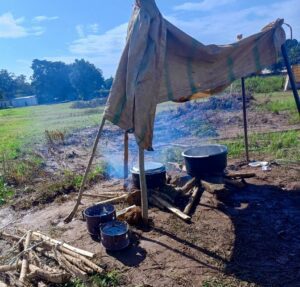
In Lira City, there is a small suburb “Teso Bar” renown for the local brew (Kongo Ting) in Lango dialect which is made from the millet or sorghum, and in Teso its known as ajon (malwa among the Bantu people).
On Tuesday, November 26th, 2024 on the eve of the launch of the 2024 Ateker Festival at the Soroti Boma Grounds, hundreds of delegates from the Ateker cluster including Bako, Dima, Iteso, Jie, Kakwa, Karamojong, Kumam, Lango, Maasai, Nyangatom, Samburu, Toposa, and Turkana started arriving one by one.
The 2024 edition of the Ateker Festival in Soroti was a momentous event that showcased cultural unity and the importance of traditional practices among the Ateker communities.
At the heart of the festival was Ajon, the local brew known as Kongo Ting in Lango and ajon in the Iteso dialect. This drink, made from millet or sorghum, is revered for its cultural significance, serving as a symbol of heritage and community spirit.
By Wednesday, November 27th, 2024, several delegates could be seen flocking a distance of about 1.5km towards the Soroti Hotel, a short distance from the main venue to sit under a tent mounted in the middle of a pitch that was barricaded by the security for safety.
Despite rainy weather, attendees gathered under a large tent at the Soroti Hotel, where a skilled Iteso woman, Jenifer Akiteng, 68 and her team served the brew in traditional style.

Multiple smaller pots and calabashes, accompanied by handmade straws (Epii in Ateso and ceke in Lango), were set up to provide comfort and a sense of shared tradition for festival-goers. The setup, complete with simple wooden chairs and the option for sipping from calabashes, created an authentic environment where people could drink and interact.
The festival’s second day was marked by animated discussions among delegates who shared stories of origin and expressed that this gathering felt like a “parliament” where cultural and historical matters were celebrated.

Even amidst the language barriers, the brew acted as a unifying force; Swahili was spoken among the Kenyan delegates, prompting participation from others, especially those with some knowledge of the language. Elders and younger attendees alike enjoyed the shared experience, deepening their cultural connections.
The brewing of Ajon is no simple task; it begins with the selection of high-quality millet or sorghum. The grains are carefully processed into a fermented paste, with strict attention to hygiene to prevent contamination.
To complete the brewing, germinated millet flour is added as malt, converting the paste into the rich, potent drink known as Ajon.
This brew is said to pack a strong punch, comparable to the most robust cocktails, and has an added reputation for its possible herbal, medicinal properties.
Ajon’s cultural role transcends just being a drink; it embodies unity, history, and an enduring symbol of togetherness among the Ateker communities.
During the festival, a liter was sold for Shs1, 500, enough to be shared by three people, underscoring how Ajon continues to be a cherished part of social gatherings, bridging generational and regional divides.














